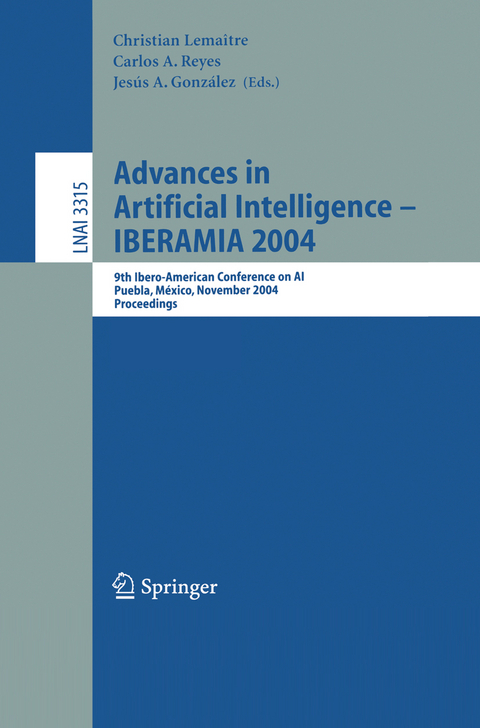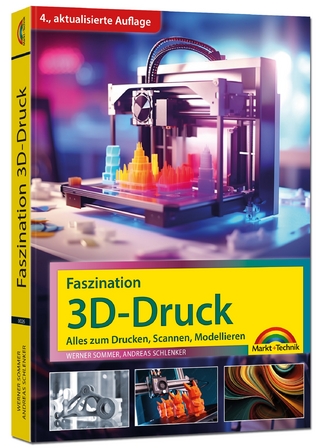
Advances in Artificial Intelligence -- IBERAMIA 2004
Springer Berlin (Verlag)
978-3-540-23806-5 (ISBN)
IBERAMIA 2004.- Checking Social Properties of Multi-agent Systems with Activity Theory.- MARCS Multi-agent Railway Control System.- Dynamic Quality Control Based on Fuzzy Agents for Multipoint Videoconferencing.- A Component and Aspect-Based Architecture for Rapid Software Agent Development.- Formalization of Cooperation in MAS: Towards a Generic Conceptual Model.- Web-Enabling MultiAgent Systems.- Gaining Competitive Advantage Through Learning Agent Models.- Towards an Efficient Rule-Based Coordination of Web Services.- Applying Rough Sets Reduction Techniques to the Construction of a Fuzzy Rule Base for Case Based Reasoning.- Dynamic Case Base Maintenance for a Case-Based Reasoning System.- A Case Base Seeding for Case-Based Planning Systems.- Handling Numeric Criteria in Relaxed Planning Graphs.- Constrainedness and Redundancy by Constraint Ordering.- To Block or Not to Block?.- Adaptive Penalty Weights When Solving Congress Timetabling.- Decomposition Approaches for a Capacitated Hub Problem.- An Efficient Method to Schedule New Trains on a Heavily Loaded Railway Network.- Studs, Seeds and Immigrants in Evolutionary Algorithms for Unrestricted Parallel Machine Scheduling.- An Investigation on Genetic Algorithms for Generic STRIPS Planning.- Improving Numerical Reasoning Capabilities of Inductive Logic Programming Systems.- Enhanced ICA Mixture Model for Unsupervised Classification.- Analysis of Galactic Spectra Using Active Instance-Based Learning and Domain Knowledge.- Adapting Evolutionary Parameters by Dynamic Filtering for Operators Inheritance Strategy.- Collaborative Filtering Based on Modal Symbolic User Profiles: Knowing You in the First Meeting.- Machine Learning by Multi-feature Extraction Using Genetic Algorithms.- Assignment of Semantic Roles Based on Word Sense Disambiguation.- Multi-session Management in Spoken Dialogue System.- Semantically-Driven Explanatory Text Mining: Beyond Keywords.- An Electronic Assistant for Poetry Writing.- Improving the Performance of a Named Entity Extractor by Applying a Stacking Scheme.- Automatic Text Summarization with Genetic Algorithm-Based Attribute Selection.- Coordination Revisited - A Constraint Handling Rule Approach.- Question Answering for Spanish Based on Lexical and Context Annotation.- A Max-SAT Solver with Lazy Data Structures.- Three Valued Logic of ?ukasiewicz for Modeling Semantics of Logic Programs.- Answer Set Programming and S4.- A Rippling-Based Difference Reduction Technique to Automatically Prove Security Protocol Goals.- On Some Differences Between Semantics of Logic Program Updates.- Towards CNC Programming Using Haskell.- Well Founded Semantics for Logic Program Updates.- A First Order Temporal Logic for Behavior Representation.- Improved Tupling for Optimizing Multi-paradigm Declarative Programs.- Polynomial Classes of Boolean Formulas for Computing the Degree of Belief.- Combining Quality Measures to Identify Interesting Association Rules.- Two Partitional Methods for Interval-Valued Data Using Mahalanobis Distances.- A Classifier for Quantitative Feature Values Based on a Region Oriented Symbolic Approach.- The Protein Folding Problem Solved by a Fuzzy Inference System Extracted from an Artificial Neural Network.- A Multi-robot Strategy for Rapidly Searching a Polygonal Environment.- Internet-Based Teleoperation Control with Real-Time Haptic and Visual Feedback.- Representation Development and Behavior Modifiers.- New Technique to Improve Probabilistic Roadmap Methods.- A New Neural Architecture Based on ART and AVITE Models for AnticipatorySensory-Motor Coordination in Robotics.- Development of Local Perception-Based Behaviors for a Robotic Soccer Player.- Statistical Inference in Mapping and Localization for Mobile Robots.- Fusing a Laser Range Finder and a Stereo Vision System to Detect Obstacles in 3D.- Adaptive Automata for Mapping Unknown Environments by Mobile Robots.- Digital Image Processing of Functional Magnetic Resonance Images to Identify Stereo-Sensitive Cortical Regions Using Dynamic Global Stimuli.- An Image Analysis System to Compute the Predominant Direction of Motion in a Foucault Pendulum.- A Perceptual User Interface Using Mean Shift.- Projected Fringe Technique in 3D Surface Acquisition.- Optimized Object Recognition Based on Neural Networks Via Non-uniform Sampling of Appearance-Based Models.- A Statistical Validation of Vessel Segmentation in Medical Images.- Structural Recognition with Kernelized Softassign.- Kernel Based Method for Segmentation and Modeling of Magnetic Resonance Images.- Real-Valued Pattern Recall by Associative Memory.- Binary Associative Memories Applied to Gray Level Pattern Recalling.- Selection of an Automated Morphological Gradient Threshold for Image Segmentation. Application to Vision-Based Path Planning.- Color Image Classification Through Fitting of Implicit Surfaces.- Transforming Fundamental Set of Patterns to a Canonical Form to Improve Pattern Recall.- Nonlinear System Identification Using ANFIS Based on Emotional Learning.- Improving k-NN by Using Fuzzy Similarity Functions.- Decomposing Ordinal Sums in Neural Multi-adjoint Logic Programs.- Comparing Metrics in Fuzzy Clustering for Symbolic Data on SODAS Format.- Estimating User Location in a WLAN Using Backpropagation Neural Networks.- On the Optimal Computation of Finite Field Exponentiation.- Particle Swarm Optimization in Non-stationary Environments.- An Efficient Learning Algorithm for Feedforward Neural Network.- Combining Data Reduction and Parameter Selection for Improving RBF-DDA Performance.- Bidirectional Neural Network for Clustering Problems.- Reducing the Complexity of Kernel Machines with Neural Growing Gas in Feature Space.- Multirecombined Evolutionary Algorithm Inspired in the Selfish Gene Theory to Face the Weighted Tardiness Scheduling Problem.- A Novel Approach to Function Approximation: Adaptive Multimodule Regression Networks.- A Novel Hybrid Approach of Mean Field Annealing and Genetic Algorithm for Load Balancing Problem.- Geodesic Topographic Product: An Improvement to Measure Topology Preservation of Self-Organizing Neural Networks.- A Genetic Algorithm for the Shortest Common Superstring Problem.- Improving the Efficiency of a Clustering Genetic Algorithm.- The Hopfield Associative Memory Network: Improving Performance with the Kernel "Trick".- A Cultural Algorithm with Differential Evolution to Solve Constrained Optimization Problems.- An Approach of Student Modelling in a Learning Companion System.- A BDI Approach to Infer Student's Emotions.- Mobile Robotic Supported Collaborative Learning (MRSCL).- Evaluation of the Teaching-Learning Process with Fuzzy Cognitive Maps.- Using Simulated Annealing for Discrete Optimal Control Systems Design.- Determination of Possible Minimal Conflict Sets Using Constraint Databases Technology and Clustering.- Implementation of a Linguistic Fuzzy Relational Neural Network for Detecting Pathologies by Infant Cry Recognition.- Adding Personality to Chatterbots Using the Persona-AIML Architecture.- DIMEx100: A New Phonetic and Speech Corpus for Mexican Spanish.
| Erscheint lt. Verlag | 18.11.2004 |
|---|---|
| Reihe/Serie | Lecture Notes in Artificial Intelligence | Lecture Notes in Computer Science |
| Zusatzinfo | XXXIII, 990 p. |
| Verlagsort | Berlin |
| Sprache | englisch |
| Maße | 155 x 235 mm |
| Gewicht | 1474 g |
| Themenwelt | Informatik ► Grafik / Design ► Digitale Bildverarbeitung |
| Informatik ► Software Entwicklung ► User Interfaces (HCI) | |
| Informatik ► Theorie / Studium ► Künstliche Intelligenz / Robotik | |
| Schlagworte | AI logics • AI Planning • Algorithmic Learning • Artificial Intelligence • Case-Based Reasoning • Data Mining • Distributed Artificial Intelligence • fuzzy system • Genetic Algorithm • Genetic algorithms • Hardcover, Softcover / Informatik, EDV/Informatik • HC/Informatik, EDV/Informatik • Knowledge • Knowledge Discovery • Knowledge Processing • Knowledge Representation • Künstliche Intelligenz • learning • machine learning • multi-agent system • Multi-agent Systems • Natural Language Processing • Neural Information Processing • neural network • robot • Robotics • Uncertainty |
| ISBN-10 | 3-540-23806-9 / 3540238069 |
| ISBN-13 | 978-3-540-23806-5 / 9783540238065 |
| Zustand | Neuware |
| Informationen gemäß Produktsicherheitsverordnung (GPSR) | |
| Haben Sie eine Frage zum Produkt? |
aus dem Bereich


